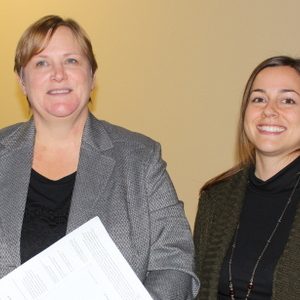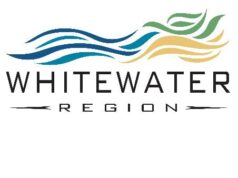by CONNIE TABBERT
Editor
COBDEN — The Muskrat Watershed Council is hoping for a $5,000 grant from the Township of Whitewater Region.
Julie Sylvestre and Karen Coulas spoke to the members of the environmental services committee yesterday afternoon. No decision will be made until budget time.
Ms. Sylvestre provided a brief history of the MWC’s major achievements in the past year while Karen Coulas provided an update on the agricultural committee’s related achievements.
“The goal of the Muskrat Watershed Council is to improve water quality in Muskrat Lake and the Muskrat Watershed,” Ms. Sylvestre said. “Our approach is to take a no blame stance on past decisions and current practices that impact water quality, and instead proceed from a point of view of shared responsibility for finding reasonable, achievable and affordable solutions that will contribute to a better future.”
Ms. Sylvestre said while not all of the $5,000 donated previously by the council has been used, it will be this year with projects that are being planned.
She outlined some major achievements completed by the MWC, including the development of a strategic plan, hosting a Canada Day Watershed celebration, two science nights and two annual general meetings, she said. There were also articles published in various newspapers, a newsletter was developed and a letter of support was provided for the funding request for a new sewage treatment plant in Cobden, she said.
With various partners, the MWC developed a water and quality and quantity sampling network with environmental specialists, local farmers and lake residents, she added.
In 2015, the MWC received funding from the Cobden and District Civitan Club to hire Dr. Rebecca L. Dalton to write a science report on the 2014 sample reports. This report was published on Aug. 7, 2015 and released at the AGM, Ms. Sylvestre said.
Due to the water testing, sources of nutrient loading in the watershed within the municipality and beyond the municipal borders, have been identified, she said.
The MWC also provided support to various projects undertaken by others on Muskrat Lake, she said.
With these accomplishments, the MWC is “confident that 2016 will be a very productive year for implementing solutions to assist in improving water quality,” Ms. Sylvestre said.
The MWC was successful in getting funding from the Ontario Ministry of Agriculture, Food and Rural Affairs (OMAFRA), she said. The money is to be used to install three or more controlled tile drainage demonstration sites and implementing other best management practices on select properties along the Snake River.
To participate in the project, local farmers had to be participants, Ms. Sylvestre said. The MWC agricultural committee connected a select group of farmers interested in land management alternatives with Dr. David Lapen, a research scientist from Agri-Food and Agricultural Canada, to look at the feasibility of installing Controlled Tile Drainage (CTD) demonstration sites.
Ms. Coulas said the tile drainage project has to be done on flat land, which is in abundance in the Pine Valley. When a farmer retrofits a gate into the tile drainage, the water must be high enough in the drain to go over the gate. This means when the water table is low, the water will remain in the tile drain and fields instead of going into the waterway, eventually ending up in Muskrat Lake, she explained. This is also keeping the phosphate out of the water, she added.
“This is a proven technique, it’s not something we’re trying that’s new,” Ms. Coulas said. “It was done at South Nation and it held back 60 percent of the phosphorous and nitrates during the time it was in use.
“It’s beneficial to the farmer because it can up his yields five to eight percent depending on what he’s planting,” she added. “It’s beneficial to everyone and could make a large difference in the Snake River and into your lake, which is what is important to everyone.”
Ms. Coulas said while the grant money is important, and would be greatly appreciated, the in-kind donations to the work of the MWC is also a necessity.
“Without the in-kind donations, we probably would have spent all of the money you have given us,she said.
Examples of in-kind donations include meeting areas and a tractor for removing the biochords, she said.
Ms. Coulas said while it may seem that things aren’t being done, they are.
Ms. Sylvestre said the money from council will be placed in reserve to be used for the controlled tile drainage project and other best management practices.
She noted the reason for not spending the money from council last year was because it takes time to understand the problems, get local participation and have enough boots on the ground to get the work done.
“We have been strategic in our process,” Ms. Sylvestre said. “We want to see change done in a meaningful way. Despite what others may believe, we are a volunteer organization that has managed to do all of this and more with the help of our partners and local people in a relatively small amount of time. We are now in a position where we have funds to implement actual solutions for the year 2016.
“We see this additional funding from the township as providing us with more leveraging power to do a whole lot more on-the-ground,” she said.
Councillor Charlene Jackson questioned if the MWC has, or will be, approaching other municipalities for funding, such as Admaston-Bromley.
Ms. Coulas said most of the land where the work will be done this year is in Admaston-Bromley Township so that council will be approached. However, she said, “They look at us differently, because they think it’s not our lake. But, we are trying to convince them through the powers of using their farmers that it’s their problem too.”
Councillor Chris Olsmtead said, “It’s refreshing to hear results coming back. We’ve been hearing lots of studies and people asking for money, so it’s actually refreshing to hear you come back with actual results.”
He questioned if the funding will be used for the three tile drains and whether there are farmers interested.
Ms. Coulas said various plots of land were looked at for where the project would be best used and the farmers were approached.
“The farmers are interested and interested in doing this,” she said. “We had seven properties that looked good and 10 farmers willing to talk to us and do something.”
Councillor Dave Mackay said the provincial drainage act states there must be a 50-foot buffer from where the provincial drain is put in.
“When you come over the hill at Pine Valley going towards Opeongo (High School), you see a provincial drain right across the road,” he said. “There’s no buffer, they’re plowing right up to the edge.”
Ms. Coulas agreed with Coun. Mackay, stating they are trying to change people’s minds, and there has been some success.
“We are working to try and convince them to stay back, but you have to start small,” she said. “If we push too hard, they’ll walk away.”
However, Coun. Mackay said OMAFRA should be enforcing that buffer zone.
Councillor Daryl McLaughlin thanked Ms. Coulas and Ms. Sylvestre for their presentation.
“It seems like there’s a wee bit of positive towards this,” he said, adding, “Keep up the great work.”






![Kenopic/Smith Auction [Paid Ad]](https://whitewaternews.ca/wp-content/uploads/2018/10/advertising-100x75.jpeg)

